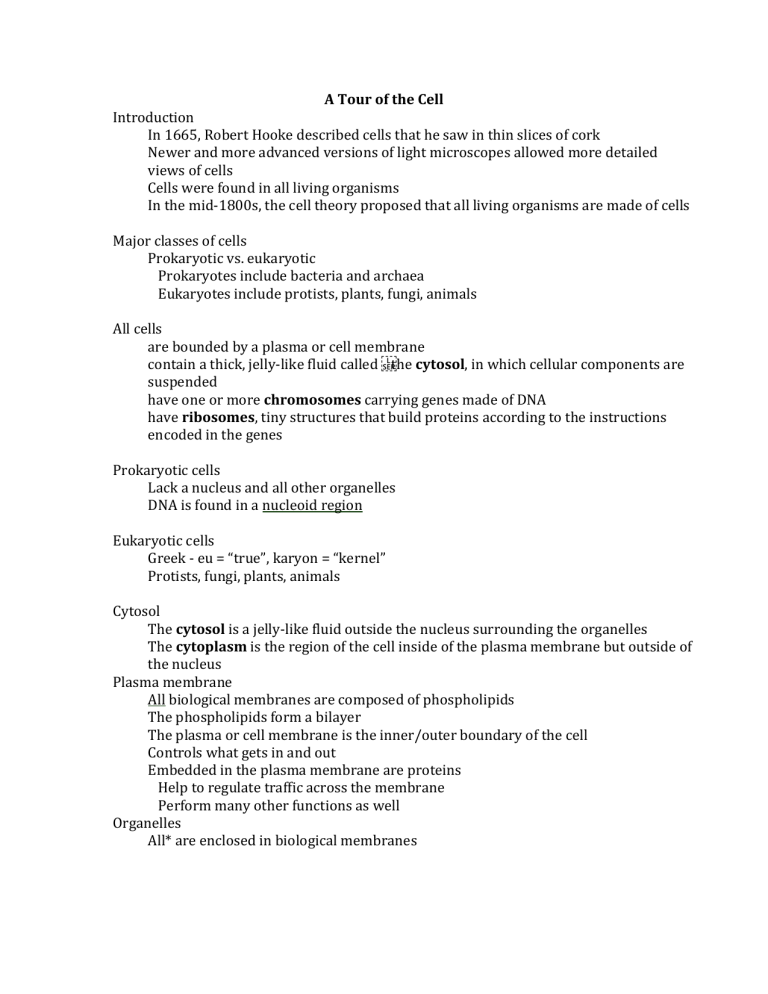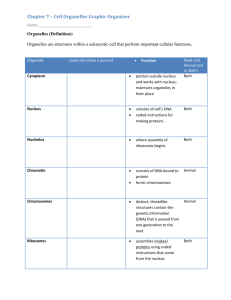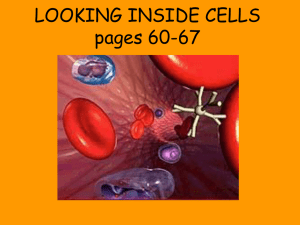A Tour of the Cell

A Tour of the Cell
Introduction
In 1665, Robert Hooke described cells that he saw in thin slices of cork
Newer and more advanced versions of light microscopes allowed more detailed views of cells
Cells were found in all living organisms
In the mid-1800s, the cell theory proposed that all living organisms are made of cells
Major classes of cells
Prokaryotic vs. eukaryotic
Prokaryotes include bacteria and archaea
Eukaryotes include protists, plants, fungi, animals
All cells are bounded by a plasma or cell membrane contain a thick, jelly-like fluid called the cytosol, in which cellular components are suspended have one or more chromosomes carrying genes made of DNA have ribosomes, tiny structures that build proteins according to the instructions encoded in the genes
Prokaryotic cells
Lack a nucleus and all other organelles
DNA is found in a nucleoid region
Eukaryotic cells
Greek - eu = “true”, karyon = “kernel”
Protists, fungi, plants, animals
Cytosol
The cytosol is a jelly-like fluid outside the nucleus surrounding the organelles
The cytoplasm is the region of the cell inside of the plasma membrane but outside of the nucleus
Plasma membrane
All biological membranes are composed of phospholipids
The phospholipids form a bilayer
The plasma or cell membrane is the inner/outer boundary of the cell
Controls what gets in and out
Embedded in the plasma membrane are proteins
Help to regulate traffic across the membrane
Perform many other functions as well
Organelles
All* are enclosed in biological membranes
Animal cells lack a cell wall but most secrete sticky substances making up the extracellular matrix
The cell wall surrounding plant cells is composed of cellulose
It provides shape, protection, and prevents the cell from absorbing too much water
Cells communicate with each other through special structures
Between plant cells are channels called plasmodesmata
They are always open, making the cytoplasm of one plant cell continuous with that of another
The surfaces of most animal cells contain cell junctions, structures that connect cells together into tissues, allowing the cells to function in a coordinated way
Adjacent animals cells are connected by gap junctions which open and close when needed
They allow the movements of small molecules and electrical signals between cells
Nucleus
The nuclear envelope is a double membrane structure with pores that allow material into and out of the nucleus
Contains DNA (genetic material)
Genes are located on the DNA
Within the nucleus, long DNA molecules and associated proteins form fibers called chromatin
Each long chromatin fiber constitutes one chromosome
Ribosomes
There are two types of ribosomes, although they are structurally identical
Some ribosomes are suspended in the cytosol, making proteins that remain within the fluid of the cell
Others are attached to the outside of the endoplasmic reticulum, making proteins that are incorporated into membranes or secreted by the cell
The genes on the DNA are copied into mRNA (messenger RNA) which exits the nucleus through the nuclear pores and moves to the ribosomes (sites of protein synthesis)
Endomembrane system
Composed of a series of coordinated organelles
Rough endoplasmic reticulum
Rough ER (RER) has attached ribosomes
Connected to the nucleus
Handles membrane and secretory proteins
Polypeptides produced from the ribosomes are folded and processed in the RER
Vesicles
The main means for transport of material through the endomembrane system
Surrounded by biological membranes
Golgi apparatus
Named after Camillo Golgi
Receives products from the ER
Responsible for modification, storage, and distribution of these products to the plasma membrane or other organelles
Other organelles
Other organelles are not directly part of the endomembrane system
Smooth endoplasmic reticulum
Network of membranes responsible for the synthesis of lipids and the detoxification of harmful substances
Lysosomes
Membrane-bound sacs of digestive enzymes
Responsible for the breakdown of various macromolecules
Digest large food particles, destroy foreign invaders, recycle organelles, destroy cells no longer needed
Mitochondria
Energy factories all eukaryotic cells
The energy stored in the chemical bonds of nutrient molecules (like sugars) is harnessed to produce ATP (energy currency of the cell)
The number of mitochondria varies depending on the type of cell
Cytoskeleton
The cytoskeleton of the cell is crucial infrastructure
Provides anchorage for the organelles
It is also involved in movement of the cell and movement of material within the cell
There are three forms of cytoskeletal elements
They differ in diameter and in function
Microfilaments, intermediate filaments, microtubules
Microfilaments play a role in cell movement by elongating at one end and decomposing at the other
Intermediate filaments form an important network of fibers to anchor the organelles
Microtubules play a structural role and also provide the “rails” on which movement of materials within the cell occur
Structures involved in movement
Cilia beat in unison
Flagella beat like whips
The Plant Cell
Plant cells have many of the same organelles and structures as animal cells
There are some organelles that are only found in plant cells:
Central vacuoles, cell walls, chloroplasts
Central vacuole functions
Breakdown of certain substances
Storage of chemicals
Fills with water to provide cell rigidity
The cell wall provides structural strength for the plant cell and helps regulate the intake and retention of water
Chloroplasts
Sites of photosynthesis
Conversion of light energy to chemical energy









